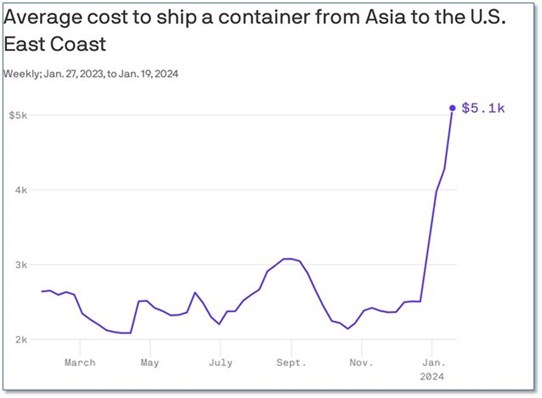Massive Sea Change (Feb. 5, 2024)
Overview
In the past, to be a sea power one required a navy. Likewise, to be a land power, one required an army. Currently, neither of the prior statements are true and the implications are massive, and they will soon be rippling through the economy.
Sea wars without navies – The ragtag Houthi rebels in Yemen have no navy yet are able to blockade the Red Sea. Forget the shocking videos of explosions of allied missiles hitting rebel camps, the real story on the ground (or rather, sea) is that major shipper AP Moller-Maersk and most other shippers are avoiding the Suez Canal and the Red Sea presumably because of extraordinary insurance premium levels. Thus, 40% more time has been added to voyages. One of the busiest trade routes in the world has been shuttered.
Figure I: Asia to U.S. East Coast Average Container Shipping Cost
Another example is Ukraine, whereby a country without a navy has been able to counter one of the world’s largest navies. (Ukraine has sunk numerous vessels with missiles and small boat drones.)
Impact – While the impact of Ukraine’s efforts already has been factored into global economies, for the most part, the Red Sea has not. Effectively, the global shipping industry has been hit with a massive reduction in supply courtesy of the Red Sea disaster and might be further impacted by the continuing capacity constraints of the Panama Canal¹. Regarding the impact, the below quote should be helpful:
“The fund [i.e., the IMF] estimates that the doubling of freight rates leads to a 0.7 percentage point increase in inflation, with the effects peaking after a year and lasting up to 18 months.”²
Hence, inflation might rise by 1% more than would have been the case without the rise in shipping costs. However, for some, the impact is more dramatic; both Tesla and Volvo have cut production in their European factories because of the lack of parts.
Just as supply constraints were a major cause of the prior inflationary burst, similar constraints are emerging. Assuming the lead time for shipping disruptions translate into inflationary pressure is six months, we might see pressure in May or June, which is particularly sensitive given the November presidential elections.
Land wars without armies – In prior wars, one needed an army to stop an army. With the widespread use of drones, traditional formulas are quickly being set aside. Hundred-dollar drones now appear capable of destroying multi-million-dollar tanks. Additionally, some of the more advanced drones can hit targets far behind front lines. Thermal imaging makes acquiring targets, including personnel, relatively easy.\
Impact – A handful of relatively inexpensive (less than a few hundred dollars) drones have the capacity of blunting and in many cases stopping sophisticated armies. Taking this one step further, a swarm of drones is unlikely to be stopped by the most sophisticated defenses. Perhaps it is only a matter of time before we see this play out on a highly valued target.
What Has Changed – There are several factors at play which have brought us to this state.
- Commoditization of Weaponry - sophisticated military technology has been commoditized. It appears that non-Western nations (probably Iran and perhaps indirectly China) have provided the Houthis with the weaponry to accurately target vessels.
- Decentralized Adversaries - Given the decentralized nature and the mobility of the Houthis, it is likely to prove difficult to counter their efforts.
- Multipolar World - we are no longer dealing with a unipolar world. The sanctions against Russia are ineffective as it can obtain revenue by selling oil to India and China. Furthermore, it can still sell natural gas to the EU but at suppressed prices.
- Dependency of Western Europe - Germany and other western European nations are dependent on relatively inexpensive Russian natural gas and petroleum and therefore not willing to provide Ukraine with the means to “win” the war, but rather to not “lose” it to date. Furthermore, voices in the Republican party are questioning the level of the US’s commitment.
- Aversion to escalation - Putin has expressed willingness to use nuclear weapons which appears to have cowed some. Given the Houthis attacks in the Strait of Hormuz and the deaths of three Americans at Tower 22, the current administration is concerned that a stronger response will spark a broader conflict.
- Importance of Cheap Manufacturing – Given that many cheap weapons (e.g. drone boats) can overwhelm expensive weapon platforms (e.g. aircraft carriers), the defense manufacturing paradigm has shifted. Legacy defense companies have specialized in developing expensive platforms. However, reliance on this dated paradigm combined with the West’s aversion to cheap domestic manufacturing and resource development may hinder its capability to respond to future conflicts. Already, the cost of a response by the US outweighs the cost of an attack by the Houthis by orders of magnitude.
Sources
[1] https://www.nytimes.com/2023/11/01/business/economy/panama-canal…
[2] https://www.imf.org/en/Publications/fandd/issues/2023/03/the-costs-of-misreading…

